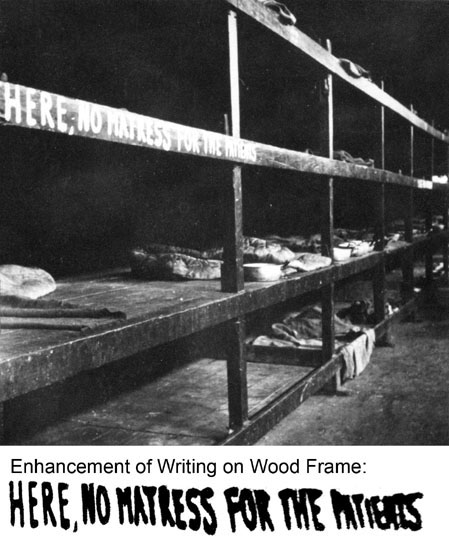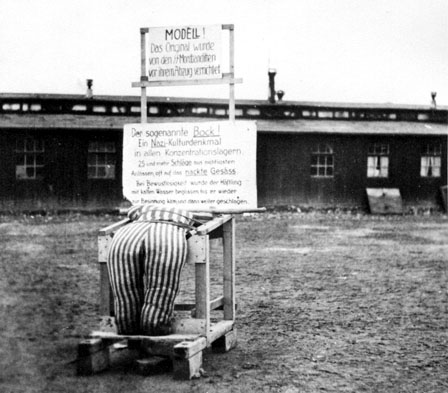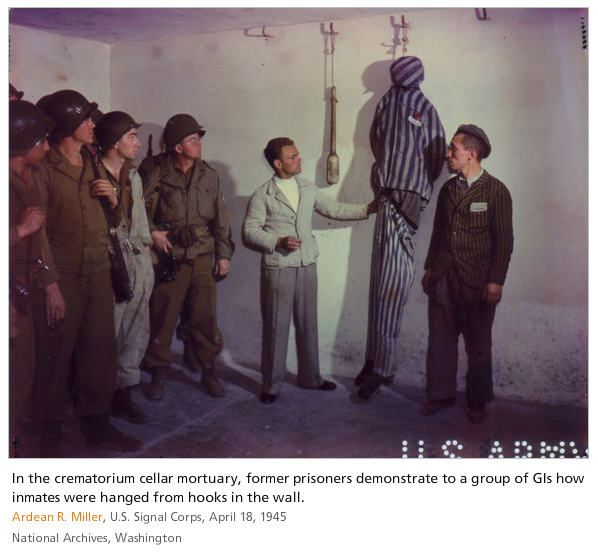Displays put up by prisoners after the Buchenwald concentration camp was liberatedAfter General Dwight D. Eisenhower visited the Ohrdruf sub-camp of Buchenwald on April 12, 1945, he ordered that as many US soldiers as possible should be brought to Ohrdruf and the Buchenwald main camp to see the atrocities that had been committed by the Nazis. The prisoners prepared exhibits for the American soldiers to see on their tour of the camp. One of the soldiers who toured the Buchenwald camp a few days after it was liberated was Corporal Norman W. Paschen who wrote an article about what he saw.  The former Buchenwald prisoner shown in the photo above is Joseph Anselma Brau, who was a French political prisoner. He was the chief doctor at the camp after Buchenwald was liberated. The words on the sign in the photo above
say "We from Silesia are ready to go back home and destroy
the Fascists (Nazis)." Silesia is a province that became
part of the German state of Prussia after the country of Poland
was divided in 1772 among Prussia, Austria and Russia. Frederick
the Great earned the title of "the Great" after Prussia
was defeated in the Seven Years War by Austria and Russia, but
he managed to save Prussia from complete ruin and keep the valuable
province of Silesia, which later became the prime industrial
area of Germany. At the end of World War II, the ethnic Germans in Silesia were expelled by the Poles, after their homes and farms had been taken from them, and they were forced to move to Germany. So it turned out that the former Polish political prisoners at Buchenwald did in fact participate in destroying the Nazis in Poland after the war.  The photo above looks like it might have been a post card because, at the bottom, it has a copy of the writing on the frame of the bunk beds. These words were written by the prisoners who wanted to point out to the soldiers on the tour of Buchenwald that the sick prisoners had no mattresses for their bunks.  The photo above shows a display put up by the prisoners in the Buchenwald camp which depicts how the prisoners were punished by 25 lashes from a whip while they were bent over a whipping block. The whipping block is a reconstruction built by the prisoners. The words on the top sign, translated into English, read as follows: Model! The original was destroyed by the SS Murdering Bandits before their departure The English translation of the first two lines on the sign below it reads as follows: The so-called Support! A Nazi cultural monument in all concentration camps The words on the lower sign then describe how the prisoners were whipped with 25 or more lashes on their naked buttocks until they were nearly unconscious. Then cold water was thrown on them to revive them and they were beaten some more. Although the whipping block was used for punishment in all the camps, no such block was found in either the Ohrdruf sub-camp or the Buchenwald main camp. The survivors of these camps had to improvise a wooden block to show the American soldiers how they had been punished. According to the testimony of Rudolf Hoess, the Commandant of Auschwitz, at the Nuremberg International Military Tribunal on April 15, 1946, this punishment was discontinued in 1942 after Reichsführer Heinrich Himmler gave a new order that the SS men were forbidden to whip the prisoners. All punishments in the Nazi concentration camps had to be authorized by the main office in Oranienburg after a report was made by the SS guards regarding an offense committed by a prisoner. A doctor had to be present during the whipping. American soldiers who toured the Buchenwald camp were told that prisoners had been killed by hanging them from hooks in the morgue until they were dead. The photo below shows an exhibit that was put up in the morgue. Note the club hanging from one of the hooks. The soldiers were told that this club was used to kill those who didn't die fast enough on the hooks.  Buchenwald OrphansCongressmen & ReportersEdward R. Murrow ReportLiberation ClaimsLiberation DayFirst American liberatorsBuchenwald SurvivorsGerman civilians tour BuchenwaldExhibits put up by prisonersBack to Buchenwald LiberationHomeThis page was last updated on June 25, 2010 |